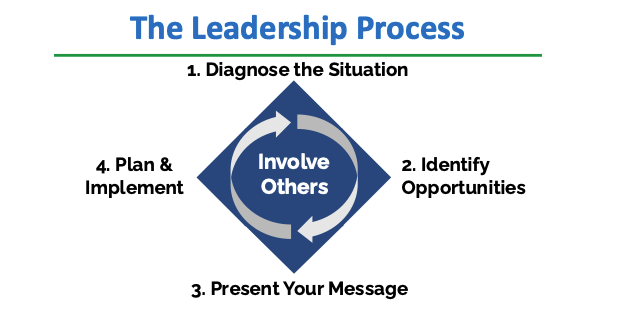
Leaders influence and inspire people to improve the status quo. They believe people have untapped potential.
I recommend you follow the four-step leadership process to improve the current situation.
In each step of the process, you build relationships and involve others to gain their insights and buy-in.

1. Diagnose the Situation
You have to understand the current environment before trying to improve it.
There are two aspects to diagnosing the current situation.
- The Framework—this includes the strategy, structure, and systems (key processes) of your organization.
- The People—this includes the employees, customers, suppliers, and others who support your organization.
Actions you can take to diagnose the situation include:
- Observe people. What do they say and do, as well as what they don’t say or do?
- Ask questions. What are people thinking and feeling?
- Analyze the numbers. What do the metrics say about the current operation? What are the strengths and improvement opportunities?
- Check in with your colleagues and other well-informed people to get their views of what’s happening.
Put the pieces together, so you have a clear picture of the current situation.
You lose credibility if you can’t clearly and accurately describe the current situation.
As Max DePree (former CEO of Herman Miller and author of Leadership is an Art) once said, “The first responsibility of a leader is to define reality.”
2. Identify Opportunities
The second requirement of a leader is to identify opportunities to improve the current operation.
Actions you can take to identify improvement opportunities:
- Change your focus. Look at things from different points of view.
- Study the best companies and individual performers. Benchmark.
- Brainstorm
- Have discussions with your customers, colleagues, consultants, and employees to solicit their ideas.
Once you create a list of improvement opportunities, do each option’s cost/benefit analysis. Identify the best one-to-three opportunities to pursue.
You must prioritize because you have a limited supply of resources (people, time, money, etc.), and people can only handle making a few changes at once.
Author and blogger Wally Bock said, “If you’re a leader today, one of the challenges is spotting and seizing the opportunities technology makes possible. What opportunities do you perceive?”
3. Present Your Message
The third step involves presenting your opportunity for improvement message to the people who will be impacted.
Convincing the audience that your ideas will work is about your credibility and the audience’s goals and needs.
Your credibility includes the type of first impression you make, your reputation, and the quality of your ideas. You need enthusiasm and total commitment (no doubt) to your presenting ideas.
Your audience includes three groups:
- Impacted Group—those people who the change will impact.
- Target Group—those people who are required to make specific changes.
- Support Group—those people who can help the target group make changes.
Remember, the audience is always thinking—What’s in it for me?
Actions you can take to prepare and deliver your message:
- Determine the best type of information to use. Consider which analogies, examples, statistics, stories, testimonials, and visual aids will most effectively explain and convince the audience that your ideas will work.
- Organize your ideas using one of these simple approaches—problem/solution or opportunity/plan.
- Practice delivering your message numerous times before going live.
- As you practice your delivery, get feedback from your colleagues, mentors, and other influential people in your network.
Your challenge is to create a message that is so clear and compelling that all employees—from the machine operator to the senior executives—see value in your proposal. You must be a true believer. It will lessen your impact if you have doubts, hesitations, or reservations about your presentation. Strong convictions get people’s attention.
4. Plan and Implement
Any change requires a plan. Change doesn’t happen until the target group has the knowledge, skills, and motivation to do what’s needed.
Each plan is unique. However, every plan must address three fundamental questions—what, when, and who.
- What actions will help the target group become able and motivated to do what’s needed?
- When will each action start and finish?
- Who is responsible for getting each task completed?
Most plans include instruction, training, incentives, removing obstacles, dealing with resistors, establishing new metrics, communicating relevant information, and actions to celebrate progress. Each plan needs to be tailored to the people and specific improvements that are being implemented.
Actions you can take to establish and implement a plan:
- Take the lead in creating a detailed plan.
- Charter a team to create a detailed plan.
- Include members of the target group and support Group on the implementation team.
- Schedule a kick-off event to start the change process formally.
- Get feedback on your plan from your colleagues, mentors, and other influential people.
Change is messy and full of surprises. Once implementation begins, you need to be flexible and adjust as needed.
Summary
Each step in the leadership process builds on the preceding steps.
This process never ends. Leaders are always looking for ways to improve the status quo.



